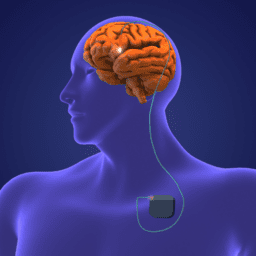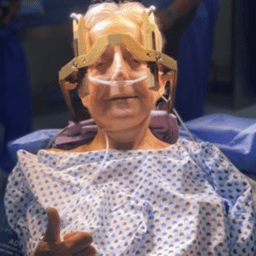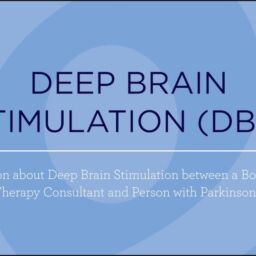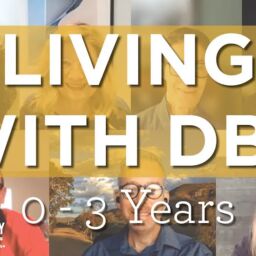If you’ve recently been diagnosed with Parkinson’s and your symptoms are manageable with little or no medication, chances are that there are more pressing things for you to learn about than deep brain stimulation (DBS). For example, you would likely benefit from prioritizing learning about exercise, the mental health impacts of Parkinson’s, and how to build a strong care team.
However, the more you know about your treatment options, the better prepared you’ll be to make informed decisions with your care team, so outside of the earliest days of living with Parkinson’s, it’s never too early to start learning about DBS.
A BRIEF OVERVIEW OF DEEP BRAIN STIMULATION
Deep brain stimulation (DBS) is a surgical intervention that involves placing small, thin wires (leads) into specific parts of the brain.
In Parkinson’s, DBS leads deliver electrical signals (stimulation) from a neurostimulator to parts of the brain affected by Parkinson’s. This stimulation helps restore more normal function and alleviates some of the symptoms associated with Parkinson’s.
There is a screening process to determine eligibility for DBS surgery. If you are eligible, your care team will consider your specific symptoms and circumstances to determine the part of your brain to target.
ELIGIBILITY FOR DBS
You may be a good candidate for DBS if you:
- Have had Parkinson’s for more than four years
- Respond well to levodopa
- Have had motor symptoms and/or medication side effects for four months or longer
- Have movement symptoms that are not adequately controlled by medication
If you meet these criteria, your care team may recommend you start the screening process for DBS. In addition to thorough evaluation of your Parkinson’s symptoms and medical history, the screening process usually includes OFF-medication symptom assessment, neuropsychological testing, and an MRI. Based on your circumstances, your care team may recommend other steps for your screening process.
Reasons to LEARN ABOUT DEEP BRAIN STIMULATION TODAY
We often have people ask about the “right time” for DBS. While each person’s circumstances and views on treatment options are unique, a good rule of thumb is that the right time to consider DBS is when your medications work but are less effective.
Still, decisions about changes in your treatment plan should be made carefully. Being familiar with DBS—or any treatment you might consider—before a change to your care plan is necessary will help you and your care team make decisions more effectively when your care needs to change.
This can be especially helpful with a decision like having DBS surgery, because although risks are low when DBS is performed in a specialized center, there are risks. It can take time to understand these risks and the potential benefits of DBS. The better you understand these things, the better prepared you’ll be to decide what treatment to pursue.
This points to one of the most important reasons to learn about DBS today: It is possible to delay consideration of DBS until it’s too late. If your symptoms don’t respond well and you receive minimal benefit from levodopa, you may no longer be a candidate for DBS.
HOW DBS MAY HELP YOU LIVE WELL WITH PARKINSON’S
Generally, Parkinson’s symptoms that respond to levodopa may respond to DBS treatment, while symptoms that do not respond to levodopa may not respond to DBS.
In 2022, Mahlknecht et al. wrote that “a robust body of evidence […] has established the efficacy of DBS in reducing OFF time and dyskinesias in levodopa-treated people with Parkinson’s. These effects go along with improvements in ON period motor function.”
A study in the New England Journal of Medicine reports that DBS correlates with significant improvements on the PDQ-39 subscales for mobility, activities of daily living, emotional well-being, stigma, and discomfort. Importantly, this study also says that DBS of the subthalamic nucleus reduces motor complications of Parkinson’s related to medication use.
DBS may also help improve quality of life by helping you decrease the amount of medication you take to manage your symptoms. Importantly, while some people significantly reduce their medications, DBS and pharmaceutical treatment of Parkinson’s are often concurrently used.
DBS can also help with motor complications and their impacts on quality of life, which is significant even when you first begin experiencing them. A 2013 study that investigated DBS safety and efficacy in people who had been living with Parkinson’s for more than four years and had begun experiencing motor complications found “[n]eurostimulation was superior to medical therapy with respect to motor disability, activities of daily living, levodopa-induced motor complications, and time with good mobility and no dyskinesia.” This supports the consideration of DBS as soon as you are eligible for the treatment.
Of course, as with any surgery or medical procedure, individual results of DBS vary, and in addition to potential benefits, there are risks associated with DBS. Discuss both the potential benefits and the possible risks of DBS with your care team.
HOW TO LEARN MORE ABOUT DBS
There are many sources of information about DBS. In addition to members of your care team, other credible options to consult include:
- Informational sessions hosted by local hospitals, physician’s offices, or nonprofit organizations
- Online and print DBS resources from reputable sources–you can start with those in our DBS resource hub
- A DBS support group or other people with Parkinson’s who have had DBS
- Research reports and articles in reputable journals
Whatever sources you consult, think critically about what you read and hear. Be sure to ask your care team questions that arise as you learn more.
How Understanding your options helps you live well
The decision to have DBS surgery is personal, complex, and should be made with your personal care team. That said, don’t make the mistake of viewing DBS as a treatment of “last resort.” Research suggests that DBS may help people with Parkinson’s improve their symptoms and quality of life even when they have recently become eligible for the treatment.
Remember: It is possible to wait too long to consider DBS. Even if you are not currently experiencing complications that would make you eligible for DBS, it is worthwhile to talk with members of your care team about it. The sooner you do, the more time you’ll have to get answers to your questions and consider your treatment preferences. The better you understand these things, the more you can maximize your ability to live well with Parkinson’s.
ADDITIONAL RESOURCES
Davis Phinney Foundation DBS Archives
Deep Brain Stimulation in Early Onset Parkinson’s
Medical Management of Parkinson’s after Initiation of Deep Brain Stimulation
Timing of Deep Brain Stimulation in Parkinson’s: A Need for Reappraisal?
This DBS educational resource was sponsored by Medtronic. This content was written by the Davis Phinney Foundation.

















